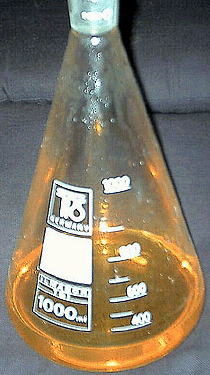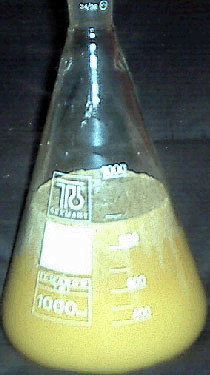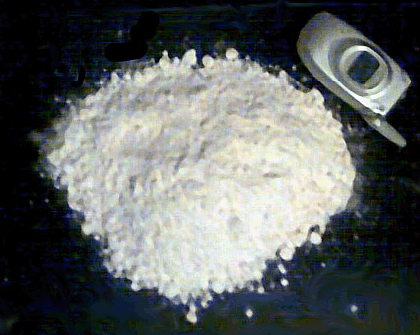
225.0g [1.0335mol] 2,5-dimethoxyphenethylamine hydrochloride was dissolved in 725mL dH2O, and poured into a 1L separating funnel. A solution of 45g [1.125mol] NaOH in 75mL dH2O was then added carefully, causing the solution to become instantly cloudy and producing no observable heat. A pale amber oil quickly fell to the bottom, and after an hour the clear bottom layer was run off into a 1L erlenmeyer flask. The aqueous layer was extracted w/2x 50mL DCM, and the extracts combined with the oil in the flask. As much as possible of the DCM was then removed by atmospheric distillation in a water bath under stirring, leaving a clear amber oil [Fig. 1 (right)].

The oil was dissolved under stirring in 300mL GAA, and the flask placed in an ice-H2O bath. A solution of 53.3mL [166.2g; 1.04mol] Br2 in 300mL GAA was added under stirring in one portion, and a reflux column was quickly attached. After ~1min the flask was removed from the ice-H2O bath and the rxn mixture left to stir at room temp. The flask became warm, and after approx. 6min spontaneously crystallised to a pale yellow-orange unstirrable mass [Fig. 2 (left)].
After this had cooled to room temp, the reflux column was replaced with a stopper and the cake broken up by 30min of vigorous shaking. This caused the rxn mixture to warm up again slightly, indicating that the rxn did not go to completion when the mass precipited. The flask was left to stand at 5C for 4hrs, then filtered. The residue was washed with 250mL EtOAc, then ground under 500mL fresh EtOAc, with which it was then stirred at the bp of the EtOAc for 5min. After cooling to room temp., the slurry was filtered and the residue stirred w/another 500mL boiling EtOAc, cooled and filtered. The residue was air-dried to give 246.1g [0.7194mol; 70%] 2,5-dimethoxy-4-bromophenethylamine hydrobromide as an odourless white powder [Fig. 3 (below, still wet!)].

Notes
- 2C-H*HCl used was of 99.7% purity.
- Bromine used was pre-chilled in a freezer then allowed to warm slightly to mp.
- No significant quantities of product could be recovered from the rxn solvent and EtOAc washings.
- The EtOAc purification is probably not the best one to use... a better method may bee washing the crude AcOH-wet 2C-B*HBr with Et2O, air-drying, then dissolution in a minimum quantity of anhydrous IPA and precipitation with Et2O.
- Distillation of the DCM from the 2C-H freebase should of course bee done under vacuum if possible.